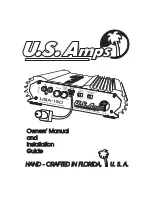
AWG 14
30 AMPS
AWG 6
80 AMPS
AWG 0
190 AMPS
AWG 12
35 AMPS
AWG 4
105 AMPS
AWG 00
215 AMPS
AWG 10
45 AMPS
AWG 2
135 AMPS
AWG 000
245 AMPS
AWG 8
60 AMPS
AWG 1
160 AMPS
AWG 0000
275 AMPS
GETTING WIRED:
Once you have established the current needs of your system, it will be of the
to properly fuse the amplifier. Remember, power connections are always the last
thing. There cannot be enough emphasis placed on the importance of proper fusing. Fuses
prevent catastrophes.
Another major consideration is wire. If you wish to build a truly high-powered system,
you must take into account the
of the system and select your wire
gauge accordingly. The following chart can be used as a guide:
UTMOST
IMPORTANCE
Always fuse each U.S. Amp product at
the recommended
amperage.
total amperage requirements
or less than
GETTING WIRED:
T
hese are real numbers, right out of the 1951
It takes real
wire to do real work. Trust us on this one.
Batteries, and the way they operate, is one of the least understood, yet critical element of any
healthy car audio system. Even small, highly efficient systems need a minimum amount of
amperage and voltage to operate properly. The average automotive battery is designed only to
the vehicle, not run the stereo, the lights, or anything else. That job goes to the vehicle
alternator, once the engine has been started.
The alternator also recharges the battery, replacing the energy used to start the engine within a
matter of minutes. The actual work done by the battery is minimal. If the current drawn by the
vehicle lights and other electrical accessories does not exceed the amperage output of the
alternator, the average battery will last for years.
The audio system, particularly the amplifiers, add to the current draw. Most stock alternators have
excess output, anywhere from 30 to 50 amps, maybe more. A safe way to determine whether your
electrical system is adequate to handle your U.S. Amp(s) is to use one-half of the amplifier fuse rating
as a constant to determine the average current draw of the system. Unless you are one of those
people who uses your amplifier to play a sine wave, (in which case you are on your own) your amp
will not draw peak current all the time when playing music. This isn’t rocket science , but it gets the
job done. Another way is to use the charts on pgs. 6 & 10 to determine
based on the impedance that each channel is operating.
For each 100 watts, when playing music, count on 7.5 amps average of average current draw.
U.S. Federal Electrician’s Code Book.
start
actual amplifier output
You have a 40 amp “cushion” with your alternator, and you want to run a USA-5500x 5
channel amplifier. The sub is run at 4 ohms, 250 watts, and the 4 mid-high channels are at 4
ohms each, or 75 watts X 4 for 300 watts. The maximum system power would be 600 watts,
BATTERIES:
EXAMPLE:
BATTERIES:
7




















